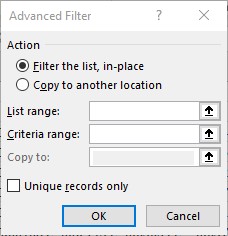Please Note: This article is written for users of the following Microsoft Excel versions: 2007, 2010, 2013, 2016, 2019, 2021, 2024, and Excel in Microsoft 365. If you are using an earlier version (Excel 2003 or earlier), this tip may not work for you. For a version of this tip written specifically for earlier versions of Excel, click here: Getting a Count of Unique Names.
Written by Allen Wyatt (last updated October 9, 2025)
This tip applies to Excel 2007, 2010, 2013, 2016, 2019, 2021, 2024, and Excel in Microsoft 365
John has a worksheet that he uses for registration of attendees at a conference. Column A has a list of each person attending, and column B has the company represented by each attendee. Each company can have multiple people attend. John can easily figure out how many individuals are coming to the conference; it is simply the number of rows in column A (minus any header rows). The more difficult task is to determine how many companies are going to be represented at the conference.
There are a few ways to determine the desired count. If you are using Excel 2021, 2024, or the version of Excel in Microsoft 365, then you can rely on a couple of great new functions. First, you can use the UNIQUE function to get a list of all of the unique company names. Combine it with the SORT function, and you can see the companies in a sorted order that allows you to quickly spot any misspellings:
=SORT(UNIQUE(B2:B50))
Or, if you prefer to have just a count of unique companies (like John wants), then you can use this formula:
=COUNTA(UNIQUE(B2:B50))
You should be aware that if there are any blank cells in the range, then UNIQUE considers the blank to be a valid unique value, so the formula will be off by one. You can expand the formula just a bit to get rid of the blanks:
=COUNTA(UNIQUE(TRIMRANGE(SORT(B2:B50))))
The SORT function sorts the range, which puts blank cells at the end of the array of cells. The TRIMRANGE function then lops off any blank cells, and that culled array of cells is what is worked on by UNIQUE.
If you are using an older version of Excel, then getting the answer you want can be a bit more convoluted. If there are no blank cells in column B, you can use an array formula (entered by Ctrl+Shift+Enter) such as the following:
=SUM(1/COUNTIF(B2:B50,B2:B50))
If there are blanks in the range (B2:B50 in this case), then the array formula will return a #DIV/0! error. If that is the case, the array formula needs to be changed to the following:
=SUM(IF(FREQUENCY(IF(LEN(B2:B50)>0,MATCH(B2:B50,B1:B50,0), ""),IF(LEN(B2:B50)>0,MATCH(B2:B50,B2:B50,0),""))>0,1))
If you prefer to not use an array formula, you can add regular formulas to column C to do the count. First, sort the table of data by the contents of column B. That way the data will be in company order. Then add a formula such as the following to cell C2 (assuming you have a header in row 1):
=IF(B2<>B3,1,0)
Copy the formula down through all the rest of the cells in column C, and then do a sum on the column. The sum represents the number of unique companies attending, since a 1 only appears in column C when the company name changes.
Of course, if you need to find the names of all the companies represented at the conference, you can use Excel's filtering capabilities. Follow these steps:

Figure 1. The Advanced Filter dialog box.
You now can easily see how many companies are being represented, along with who those companies are.
Finally, you can also use a simple PivotTable to figure out the number of companies. Create the PivotTable based on your data, using the company name column as a row label. This will give you the list of unique company names, which can easily be counted.
ExcelTips is your source for cost-effective Microsoft Excel training. This tip (7562) applies to Microsoft Excel 2007, 2010, 2013, 2016, 2019, 2021, 2024, and Excel in Microsoft 365. You can find a version of this tip for the older menu interface of Excel here: Getting a Count of Unique Names.

Solve Real Business Problems Master business modeling and analysis techniques with Excel and transform data into bottom-line results. This hands-on, scenario-focused guide shows you how to use the latest Excel tools to integrate data from multiple tables. Check out Microsoft Excel Data Analysis and Business Modeling today!
The filtering capabilities of Excel are very helpful when you are working with large sets of data. You can create a ...
Discover MoreWant a tool that will help you toggle AutoFilter on and off? Excel provides some tools you can use, but you need to be ...
Discover MoreExcel's AutoFilter tool is a great way to make a long list of items much more manageable. This tip explains how to set up ...
Discover MoreFREE SERVICE: Get tips like this every week in ExcelTips, a free productivity newsletter. Enter your address and click "Subscribe."
There are currently no comments for this tip. (Be the first to leave your comment—just use the simple form above!)
Got a version of Excel that uses the ribbon interface (Excel 2007 or later)? This site is for you! If you use an earlier version of Excel, visit our ExcelTips site focusing on the menu interface.
FREE SERVICE: Get tips like this every week in ExcelTips, a free productivity newsletter. Enter your address and click "Subscribe."
Copyright © 2025 Sharon Parq Associates, Inc.
Comments